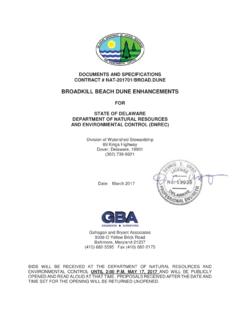Transcription of Beach Nourishment: Setting the Record Straight
1 Beach nourishment : Setting the Record Straight Clearing up a few common misunderstandings about . Army Corps of Engineers coastal storm damage reduction projects in New Jersey 1) Why spend all this money for a solution that protects only along the ocean but does nothing about the back bays? Isn't flooding the biggest single direct cause of storm damage? Oceanfront Beach nourishment is the most cost-effective solution that helps protect against all three types of coastal storm damage, including flooding. Coastal storms cause damage to buildings and infrastructure in three different ways: Direct impact from wind and waves Beach erosion that in turn undermines foundations and roadways Flooding Along the oceanfront, a dune-and-berm* Beach nourishment system (*the "berm" is the deeper and wider Beach between the dune and the water) addresses all three of these causes.
2 The dune protects the community and the berm protects the dune The dune acts as a barrier against wind and wave impact The dune reduces the amount of flooding due to direct overwash First the berm, then the dune, absorb much of the erosion before it can reach buildings or infrastructure The berm and dune also absorb erosion that could otherwise cause a breach in the barrier island, opening a new connection between the ocean and the back bay and causing increased flooding from the back bay (such as actually happened at Mantoloking and in the Barnegat Bay during Sandy) A common misperception is that Beach nourishment projects "fail" when they are "damaged" in storms and have to be subsequently restored, when in fact they are sacrificial by design. The operating principle is that in a storm, something is going to absorb the blow. Better that it be sand, which doesn't get broken, it just gets moved and can be moved back again than buildings and infrastructure, which do get broken and are a lot more expensive to fix or replace.
3 In contrast, any solution along the back of a barrier island by virtue of location would address only one of these three causes: flooding. Under post-Sandy congressional legislation, the Corps is now looking into the feasibility of such projects as a desirable next step. But when Congress first authorized the studies that resulted in the Beach nourishment projects now in place or under construction, the focus was clearly on oceanfront solutions in terms of "best bang for the buck". With respect to storm damages, frequency and severity are two different things. While bayside flooding may occur more often and affect a wider area on average, the damage caused by hurricanes, tropical storms and nor'easters is typically far greater per event due to the combined effects of wind and wave impact, erosion, and flooding. The aftermath of the March 1962 storm in Harvey Cedars and of Sandy in Mantoloking vividly demonstrate the type of damage and scale of destruction that can result from one coastal storm, but which would never result from bayside flooding.
4 Thus the total damage potential from coastal storms is greater. 2) How can "one size fits all" be the right answer? Shouldn't each community be free to make its own decision? Along any barrier island, the decisions of any one community can directly affect its neighbors on either side, especially on a project that works best when continuous. While communities may be politically and legally separate from one another, on the same barrier island they are still physically interrelated. When a physical project crosses those political and legal boundaries, one community's decisions about that project may also have consequences for its neighbors. Continuity is one of the key ingredients to the success of an engineered dune-and-berm system. Unlike some of the more traditional "hard" structures such as groins and seawalls that would "rob Peter to pay Paul" accumulating sand in some areas at the expense of others down the shore the "soft" approach of Beach nourishment emulates nature by minimizing those sudden shifts from one community to the next.
5 Non-continuous Beach nourishment is still better than nothing for those communities directly affected, as evidenced along Long Beach Island during Sandy. But at either end of those completed sections, there is considerably more risk to that community that chose to participate in the project because an adjacent community declined to do likewise. 3) Once the dune and beachfill are in place, what's to keep the local community from being stuck with the bill for future renourishments if federal and state funds dry up? If the money's not there, the work simply doesn't get done; no one's forced to follow through with renourishment at the local level. The simplest answer is that it won't, because it hasn't. While the State of New Jersey has thus far ensured adequate funding for its share of the Corps' coastal program, there have already been several project renourishments for which Congress did not provide the necessary federal funds as scheduled.
6 As a result, those renourishments were simply put on hold until those federal funds might become available the state was under no obligation to make up the difference. Nor was any community required to do likewise. Under post-Sandy federal legislation, much of the initial construction is 100 percent federally funded, in which case state and local budgets are unaffected. But all future renourishment will be cost-shared. If any community declines to provide its local cost share per agreement with the state, one of two things can happen: The state can make up the difference out of its own funds and proceed with renourishment. The state can leave that portion underfunded and not proceed with renourishment. In the latter case, is initial construction a waste of money if a community "drops out" of future renourishments? No. All that means is that for at least three to five years, that community will benefit from significantly more protection than it would have experienced otherwise and then gradually would return to pre-project conditions.
7










